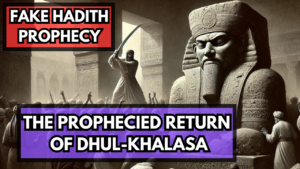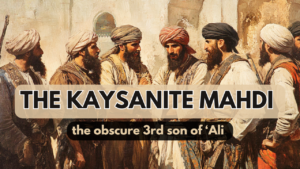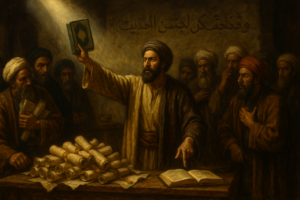Caedmon’s Divine Calling: An Early Christian Story with Striking Parallels to Muhammad’s First Revelation
There was once a man named Caedmon, a brother specially marked by the grace of God. His talent for composing godly and religious songs was not learned from men or books but was granted to him by divine inspiration. Whatever he absorbed from the Holy Scriptures, he quickly turned into beautiful poetry in English, his native tongue. Though others had attempted to write religious poems, none could match his skill, for his gift was divinely bestowed.
Caedmon had lived a secular life for many years, and unlike others, he had never learned to sing. Whenever a feast was held where everyone took turns singing, Caedmon would avoid it. When the harp came his way, he would rise, leave the gathering, and return home rather than sing.
One evening, as usual, Caedmon left a feast and went to the stable where he was responsible for tending the cattle that night. After completing his tasks, he lay down to rest. As he slept, he dreamt that a man stood beside him, calling him by name. “Caedmon,” the figure said, “sing me something.” Caedmon replied that he could not sing, which was why he had left the feast earlier. But the figure insisted, “Nevertheless, you must sing.”
When Caedmon asked what he should sing about, the figure replied, “Sing about the beginning of created things.” Instantly, Caedmon began to sing verses in praise of God the Creator, words he had never heard before. Upon waking, Caedmon remembered every word of the song, which had come to him in the dream.
The next morning, he went to his master, the Reeve, and told him about his experience. Impressed, the Reeve took Caedmon to the abbess, who asked him to recount his dream and sing the song in the presence of learned men. After hearing him, they all concluded that Caedmon had been blessed with divine grace. Thus, his gift for composing sacred poetry was recognized, and he soon added more verses praising God.
This narrative of Caedmon’s divine calling, preserved in Bede’s Ecclesiastical History of the English People, written in 731 CE at Whitby Abbey under the guidance of St. Hilda, has remarkable parallels with another famous religious story—the first revelation of the Prophet Muhammad as described in the Islamic tradition.
Muhammad’s First Revelation: A Similar Narrative
The story of Muhammad’s first revelation, as recorded in Kitab al-Maghazi by Ibn Ishaq, bears striking similarities to Caedmon’s experience. According to this account, Muhammad would retreat to the cave of Hira each year to meditate. On one such night, the angel Gabriel appeared to him, bringing the command of God.
The angel asked Muhammad to read, but Muhammad replied, “I cannot read.” Gabriel pressed him tightly, nearly suffocating him, and then released him, repeating the command, “Read.” After three attempts, Gabriel revealed the first verses of the Qur’an: “Read in the name of your Lord who created; He created man from a clot. Read, and your Lord is the most generous, who taught by the pen, taught man that which he knew not” (Qur’an 96:1-5).
Like Caedmon, Muhammad initially resisted the divine request, claiming that he was unable to comply. But both eventually submitted to the divine will and recited the words that were revealed to them. Afterward, just as Caedmon went to the Reeve, Muhammad sought validation of his experience from his wife, Khadijah, and her Christian cousin, Waraqah, who affirmed that the vision was from God.
Examining the Parallels
These two narratives—the story of Caedmon and the story of Muhammad—share several key elements that are too similar to be dismissed as mere coincidence:
- Seclusion: Both Caedmon and Muhammad were in secluded, humble locations when their divine encounters occurred—Caedmon in the cattle stable and Muhammad in the cave of Hira.
- Divine command to recite or sing: Both figures were commanded by a divine being to recite or sing, despite their initial protests of inability.
- Reluctance and eventual compliance: Both initially resisted the command but ultimately complied, with the words inscribed upon their hearts.
- Seeking validation: After their experiences, both sought out authority figures—Caedmon went to the abbess, while Muhammad went to Khadijah and Waraqah—for confirmation that their experiences were indeed from God.
Theories of Influence or Common Source
The striking similarities between the stories of Caedmon and Muhammad’s first revelation raise intriguing questions. Did one of these stories influence the other? Or do they both draw from a common source?
One theory suggests that the story of Caedmon might have influenced the Zubayrid version of the Ikra narrative. Given the wide transmission of Christian and Islamic stories through oral traditions, it’s possible that Caedmon’s story reached the Zubayrid court and was adapted into the Islamic narrative. However, the geographic and cultural distance between Caedmon’s England and Muhammad’s Arabia makes this theory less likely.
Another theory proposes that both stories were independently inspired by biblical themes. For example, in the Book of Isaiah, there is a passage where a prophet is commanded to cry out, but he responds, “What shall I cry?” (Isaiah 40:6). Similarly, both Caedmon and Muhammad are commanded to recite or sing, and both express hesitation. The biblical influence is a plausible common thread, especially considering that both Christianity and Islam share a deep connection to the biblical tradition.
Conclusion
While the exact nature of the relationship between these two stories remains uncertain, the parallels are too strong to be ignored. Whether through direct influence, shared oral tradition, or common biblical inspiration, the stories of Caedmon and Muhammad’s divine callings highlight the universality of religious experiences across cultures.
In future articles, we will explore other conflicting accounts of Muhammad’s first revelation and examine their historical context. For now, we leave you with these thought-provoking similarities between two figures separated by centuries and geography but united in their divine encounters.



